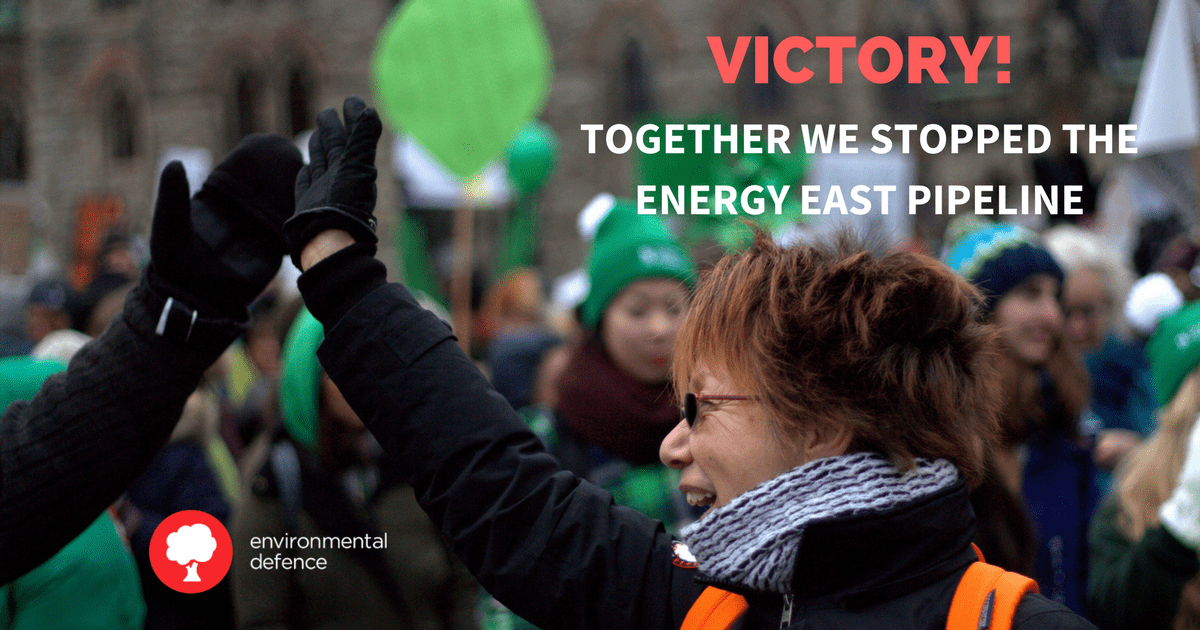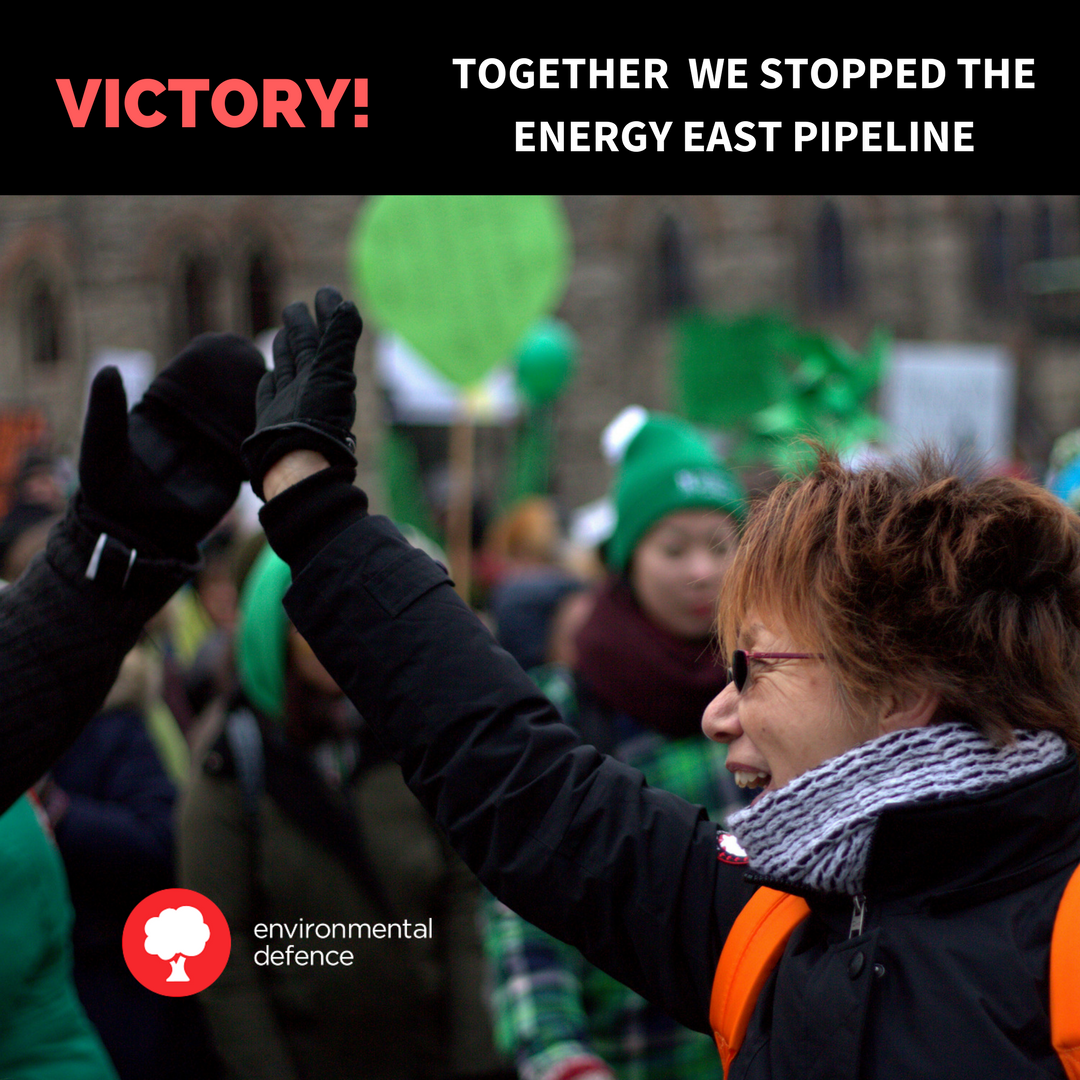This month’s decision by TransCanada to cancel its proposed pipeline to send 1.1 million barrels per day of tar sands bitumen to the east coast is good news for the climate and all Canadians that stood up for our land, water and communities.

But Energy East’s proponents have been launching an all-out air war lamenting the pipeline’s demise and spreading hysteria about the implications for Canada’s economy.
A former TransCanada executive blamed Energy East’s cancellation on a dysfunctional regulatory process and suggested the federal government was hostile to the oil industry. The business lobby said the energy project review process was scaring investment away from Canada. Commentators and politicians in Alberta went so far as to call the pipeline’s demise the rebirth of Western alienation and a threat to Confederation.
These claims don’t match with reality.
To cut through all the fear-mongering and misinformation, here’s ten key takeaways to “clean the pipes” following the death of Energy East:
- Energy East was cancelled because TransCanada knew it didn’t make economic sense. New pipelines can’t be justified during a time of low oil prices, declining investment in the tar sands, pipeline overcapacity, and an unstoppable transition to renewable energy.
- Energy East was meant to be an export pipeline. Pipeline proponents claimed to the bitter end that Energy East would supply eastern Canada with western Canadian oil and displace foreign oil imports. But this has always been a myth. Eastern Canadian refineries are already adequately supplied and the purpose of Energy East was to load oil onto tankers bound for the U.S. Gulf Coast. Irving Oil, the refinery at the end of the pipeline in New Brunswick, said the company would continue importing oil from Saudi Arabia even if Energy East was built.
- Canada doesn’t need new pipelines. Not only are new tar sands export pipelines not needed, but most of Canada’s existing capacity to transport oil will become unnecessary in the near future, as the global economy rapidly shifts away from fossil fuels.
- The NEB was right to assess Energy East’s carbon pollution. Many pipeline supporters pointed to the NEB’s decision to consider the upstream and downstream greenhouse gas (GHG) emissions as the reason TransCanada pulled the plug. But the GHG assessment is legitimately within the NEB’s jurisdiction and a sensible move to ensure Energy East doesn’t become a stranded asset in tomorrow’s low-carbon economy. It would be irresponsible not to conduct a climate test that ensures major energy projects are aligned with Canada’s climate commitments and are economically viable in a world moving away from fossil fuels.
- Grassroots climate action shone a spotlight on the risks of Energy East and delayed the pipeline long enough for its business case to collapse. The formal National Energy Board (NEB) review process had not even begun when TransCanada pulled the plug on Energy East. This is thanks to years of organizing and mobilizing to delay the pipeline, including the court challenge that forced TransCanada to cancel its proposed export terminal on the Saint Lawrence River, public pressure to force the Ontario government to assess the pipeline’s risks to Ontario, the Charest Affair that forced the NEB Board members reviewing Energy East to resign, the coming together of First Nations to oppose tar sands expansion, and finally the push from Canadians for the NEB to consider carbon pollution in its review. Energy East was first proposed in 2013 and supposed to begin shipping oil in 2018. But people-powered delays to the process staved off Energy East long enough to fundamentally change the economic case for the pipeline.
- Canadians recognize the need to get off oil. Recent polling shows Canadians understand that climate change is happening now and want to be part of the solution. Canadians increasingly expect that the demand for oil will decrease, and are turning against pipelines. In fact in just a few months, the tide has shifted from the majority of Canadians (51 per cent) expecting the demand for oil to increase over the next 10 years, to less than one third (31 per cent) still believing this.

7. Canada’s economy is doing just fine without pipelines and tar sands expansion. Energy East supporters fear-monger about economic doom and gloom if Canada doesn’t build new pipelines to expand tar sands production. But the tar sands account for just two per cent of Canada’s GDP and Canada is expected to see the highest economic growth in the G7 in 2017.
8. Other pipeline proposals have their own problems. Many pipeline boosters responded to Energy East’s cancellation by ramping up the pressure to build other proposed tar sands pipelines. But Kinder Morgan, the proposed pipeline to the west coast, faces sixteen court challenges, determined public and First Nations opposition in British Columbia, and a provincial government committed to stopping the pipeline. Enbridge Line 3 faces regulatory hurdles in Minnesota and growing Indigenous opposition. And questions about the need for TransCanada’s Keystone XL continue to swirl, as court challenges and resistance grows from landowners, farmers, environmental groups and Native Americans. Energy East’s cancellation in no way removes the significant obstacles to these pipelines being built.
9. There will be no demand for oil in a climate-safe future. Largely lost in the media response to Energy East’s cancellation was a failure to comprehend the scale and gravity of the need for rapid climate action. Not only does tackling climate change require us to stop building new fossil fuel infrastructure, but it means a definitive end to fossil fuels by around mid-century.
10. It’s time to move forward with climate solutions. The cancellation of Energy East marks the beginning of the end of the age of oil. It’s time to move past the myth that we can continue pumping carbon into the atmosphere, and get on with building the clean economy.









